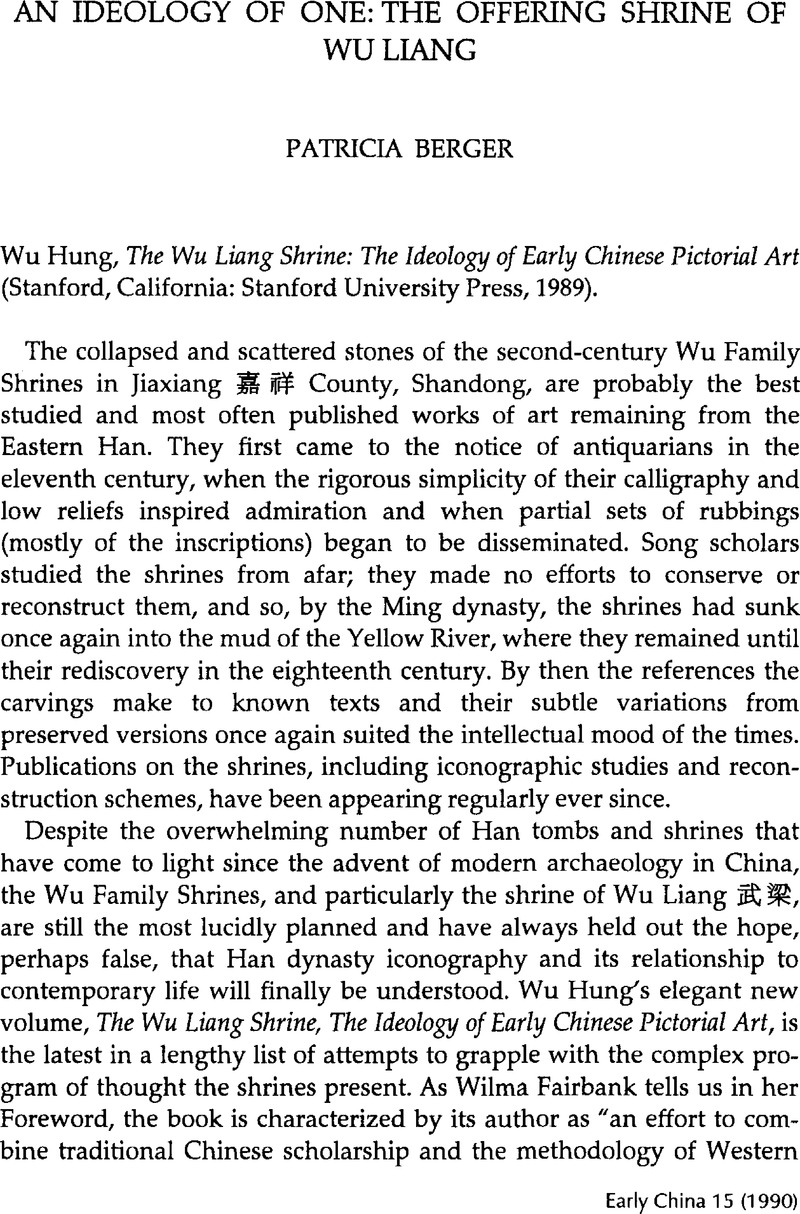Published online by Cambridge University Press: 26 March 2015

1. This idea of the polysemy of symbols has long been a topic of discussion among anthropologists; see e.g., Turner, Victor, The Forest of Symbols, (Ithaca, N.Y.: Cornell University Press, 1967)Google Scholar.
2. See, e.g., Shi, Duan 段拭, Han Hua 漢畫 (Beijing: Gudian Wenxue Press, 1958)Google Scholar.
3. James, Jean M., “An Iconographie Study of Two Late Han Funerary Monuments: The Offering Shrines of the Wu Family and the Multichamber Tomb at Holingol” (Ph.D. diss: U. of Iowa, 1983)Google Scholar.
4. Soper, Alexander, “King Wu Ting's Victory over the ‘Realm of Demons’”, Artibus Asiae 17.1 (1954), 55–60CrossRefGoogle Scholar; and “The Purpose and Date of the Hsiao-t'ang-shan Offering Shrine: A Modest Proposal”, Artibus Asiae 36.4 (1974), 249–66CrossRefGoogle Scholar.
5. Bulling, A., “Three Popular Motifs in the Art of the Eastern Han Period: The Lifting of the Tripod, the Crossing of a Bridge, Divinities”, Archives of Asian Art 20 (1966–1967), 25–53Google Scholar; “Historical Plays in the Art of the Han Period, Archives of Asian Art 21 (1967–1968), 20–38Google Scholar; and Berger, Patricia, “Purity and Pollution in Han Art”, Archives of Asian Art 36 (1983), 40–58Google Scholar.
6. Powers, Martin, “Hybrid Omens and Public Issues in Early Imperial China”, Bulletin of the Museum of Far Eastern Antiquities 55 (1983), 1–55Google Scholar; “Pictorial Art and Its Public in Early Imperial China”, Art History 7.2 (1984), 135–63CrossRefGoogle Scholar; and “Social Values and Aesthetic Choices in Han Dynasty Sichuan”, in Stories from China's Past (San Francisco: Chinese Cultural Foundation, 1987), 54–63Google Scholar.
7. James, J., “The Dating of the Left Wu Family Offering Shrine,” Oriental Art 31 (1985), 34–41Google Scholar.
8. Berger, “Purity and Pollution in Han Art.”
9. Powers, , “Hybrid Omens and Public Issues,” 2Google Scholar.
10. Powers, , “Hybrid Omens and Public Issues,” 5Google Scholar.
11. Powers, , “Hybrid Omens and Public Issues”, 7–12Google Scholar.
12. Dubs, Homer, “An Ancient Chinese Mystery Cult”, Harvard Theological Review 35 (1942), 236–7CrossRefGoogle Scholar.
13. Hung, Wu, “Buddhist Elements in Early Chinese Art”, Artibus Asiae 47 (1986), 263–376CrossRefGoogle Scholar.
14. Wu Hung, “Buddhist Elements”, fig. 1.
15. Wu Hung, “Buddhist Elements”, fig. 8.
16. Zhaoyu, Zeng 曾昭氣 et. al., Yinan gu huaxiang shimu fajue baogao 折南古畫像石墓發掘吿 (Nanjing: Nanjing Museum, 1956, pls. 67, 3.2Google Scholar.
17. Zhongyi, Li 黎忠義, “Changli shuikuHamnuqun fajue jianbao” 昌黎水庫漢墓群發掘簡報, Wenwu cankao ziliao 文物參考資料 1959.12, 29–40Google Scholar.
18. See Zürcher, Eric, The Buddhist Conquest of China (Leiden: E.J. Brill, 1972), 26–7Google Scholar. Zürcher cites passages in Hou-Han shu 後溪書 and Sanguo zhi 三國志.
19. This theory was first proposed by Rong Geng 容庚 in 1936, and was taken up by Wilma Fairbank, Nagahiro Toshio, Doris Croissant, and most others. See Geng, Rong, Han Wu Liang ci huaxiang lu 漢武梁祠畫像錄 (Beijing: Archaeological Society of Beijing, 1936)Google Scholar; Fairbank, Wilma, “The Offering Shrines of'Wu Liang Tz'u’”, reprinted in Adventures in Retrieval, Harvard-Yenching Institute Studies, 28 (Cambridge, Mass.: Harvard University Press, 1972), 85Google Scholar; Toshio, Nagahiro, “A Study on the Central Pavilion Scenes of the Wu Family Shrines”, trans. Hickman, Money, Acta Asiatica 2 (1961), 40–58Google Scholar; and Croissant, Doris, “Funktion und Wanddekor in der Opferschreine von Wu-liang-tz'u,” Monumenta Serica 23 (1964), 151–2CrossRefGoogle Scholar.
20. See Chavannes, Edouard, Mission Archéologique dans la Chine septentrionale (Paris: E: Leroux, 1909–1915), vol. I, pls. 45–6Google Scholar.
21. Nagahiro Toshio,” A Study on the Central Pavilion Scenes of the Wu Family Shrines.”
22. Minao, Hayashi, “Go-Kan jidai no shaba gyōretsu” 後漢時代の車馬行列, Tōhōgakuhō 東方學報, 37 (1966), 189–90Google Scholar.
23. Sili, Wang 王思禮, “Shandong Feicheng Hanhuaxiang shimu diaocha” 山東月巴城漢畫像石墓調查, Wenwu cankaoziliao 1958.4, 34–36Google Scholar.
24. “Shandong Cangshan Yuanjiayuannian huaxiang shimu” 山東蒼山元嘉元年畫像石墓, Kaogu 考古 1975.2, 124–34Google Scholar.
25. Soper, Alexander, “Life-motion and the Sense of Space in Early Chinese Representational Art,” Art Bulletin 30.3 (1948), 167–86CrossRefGoogle Scholar.
26. Powers, Martin, “Pictorial Art and Its Public in Early Imperial China”, Art History 7.2 (1984), 137, 142CrossRefGoogle Scholar.